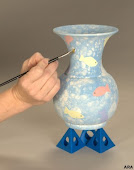Blog Archive
-
▼
2008
(75)
-
▼
November
(11)
- John Singer Sargent, Nonchaloir (Repose), 1911
- John Singer Sargent, Street in Venice, 1882
- Romare Bearden, Tomorrow I May Be Far Away, 1967
- Bob Thompson (Oil Painter), Tree, 1962
- Jacob Lawrence, Daybreak - A Time to Rest, 1967
- Horace Pippin, Interior, 1944
- Joshua Johnson, The Westwood Children, c. 1807
- Smallest Minature Oil Paintings by Norris Castillo
- Winslow Homer, Hound and Hunter, 1892
- Winslow Homer, Breezing Up (A Fair Wind), 1873-1876
- Winslow Homer, Home, Sweet Home, c. 1863
-
▼
November
(11)
Friday, November 28, 2008
 Exasperated by the demands of his sitters, Sargent proclaimed portraiture to be “a pimp’s profession” and by 1907 resolved never to accept another oil paintings portrait commission. During his later years, the fine art reproduction artist devoted himself to creating decorative murals for public buildings and to oil paintings watercolors and small canvases purely for pleasure.
Exasperated by the demands of his sitters, Sargent proclaimed portraiture to be “a pimp’s profession” and by 1907 resolved never to accept another oil paintings portrait commission. During his later years, the fine art reproduction artist devoted himself to creating decorative murals for public buildings and to oil paintings watercolors and small canvases purely for pleasure.In 1911 Sargent vacationed with his sister’s family in Switzerland, where he painted Nonchaloir (“nonchalance”). A casual character study instead of a formal oil paintings portrait, it depicts Sargent’s niece Rose-Marie Ormond Michel, whom he nicknamed “Intertwingle” because of her agile, intertwined poses. Influenced by the “fine art for art’s sake” movement, the oil painter unified the color scheme with the amber light of a lazy afternoon. The straight lines of the posh furnishings in the Swiss hotel accentuate the swift brushstrokes used to delineate his niece’s fingers, hair, cashmere shawl, and satin skirt.
Late in life, Sargent also returned to landscapes oil paintings, working almost exclusively outdoors. He spent the autumn of 1908 relaxing on the Spanish island of Majorca. Valdemosa, Majorca: Thistles and Herbage on a Hillside is a tour de force of Sargent’s brushwork. Against the sandy soil, the sunny highlights that gleam from roots and twigs create abstract networks of white paintings.
Thursday, November 27, 2008
 Although best known for his fashionable formal portraits, Oil paintings, Fine art gallery reproductions John Singer Sargent was equally adept at landscapes paintings and scenes of daily life. His early fame and astonishing facility with a brush prompted the American expatriate novelist Henry James, his close friend, to comment on “the slightly 'uncanny' spectacle of a talent which on the very threshold of its career has nothing more to learn.”
Although best known for his fashionable formal portraits, Oil paintings, Fine art gallery reproductions John Singer Sargent was equally adept at landscapes paintings and scenes of daily life. His early fame and astonishing facility with a brush prompted the American expatriate novelist Henry James, his close friend, to comment on “the slightly 'uncanny' spectacle of a talent which on the very threshold of its career has nothing more to learn.”Another of Sargent’s friends was the French impressionist Claude Monet, with whom he shared a love of painting en plein air, or out-of-doors. Street in Venice, created during the second of Sargent's numerous visits to that city, was done on the spot. Mediterranean sunshine penetrates the narrow confines of the Calle Larga dei Proverbi, a back alley near the Grand Canal.
The emptiness of the silent street implies that Sargent depicted siesta, the time when many Italians rest for three hours at midday. One of two men conversing in the shadows is distracted by a girl strolling alone. Her skirt’s rustling hem and shawl’s flowing fringe are rendered with indistinct strokes that suggest her rapid pace will soon carry her beyond his lingering gaze. This combination of technical skill and emotional intensity goes far toward explaining why Sargent received more honors and medals than any previous artist, European or American.
Tuesday, November 25, 2008
 Born in Charlotte, North Carolina, seat of Mecklenburg County, on September 2, 1911, Romare Bearden, an oil painters grew up in a middle-class, African American family. Both parents Bessye and Howard were college-educated, and it was expected that Romare would achieve success in life. About 1914, his family joined the Great Migration of southern blacks to points north and west. Although slavery had been abolished during the early part of the 20th century, Jim Crow laws kept many blacks from voting and from equal access to jobs, education, health care, business, land, and more. Like many southern black families, the Beardens settled in Harlem section of New York City. Romare would call New York home base for the rest of his life.
Born in Charlotte, North Carolina, seat of Mecklenburg County, on September 2, 1911, Romare Bearden, an oil painters grew up in a middle-class, African American family. Both parents Bessye and Howard were college-educated, and it was expected that Romare would achieve success in life. About 1914, his family joined the Great Migration of southern blacks to points north and west. Although slavery had been abolished during the early part of the 20th century, Jim Crow laws kept many blacks from voting and from equal access to jobs, education, health care, business, land, and more. Like many southern black families, the Beardens settled in Harlem section of New York City. Romare would call New York home base for the rest of his life.Throughout his childhood, Bearden spent time away from Harlem, staying with relatives in Mecklenburg County, Pittsburgh, Pennsylvania, and Lutherville, Maryland. Bearden's memory of these experiences, as well as African American cultural history, would become the subjects of many of his works. Trains, roosters, oil paintings, fine art gallery reproductions, cats, landscapes, barns, and shingled shacks reflected the rural landscape of his early childhood and summer vacations. Scenes of his grandparents' boardinghouse, bellowing steel mills, and African American millworkers recalled his Pittsburgh memories.
In Tomorrow I May Be Far Away, Bearden reflects on his childhood memories of Mecklenburg County. There is a focus or elevation of the everyday that becomes a frequent motif in both his North Carolina and Harlem imagery. Bearden employed a variety of media to create this collage, including cuttings from magazines, sample catalogs, wallpaper, art reproductions, oil paintings and painted papers. Parts of the surface have also been reworked with spray oil paint and charcoal or graphite. Over the next thirty years, Bearden's collages would continue to evolve, employing flat areas of color defined by cut papers as wells as more patterned or textured areas created by cuttings of preprinted images, hand-painted papers, foils, and fabrics. Surface manipulation was also an ongoing concern for the oil painting artist, who explored news ways to rework the surface, including the use of bleach or peroxide, sandpaper, and perhaps even an electric eraser.
Although Bearden is best-known for his work in collage he achieved success in a staggering array of media, including watercolor, gouache, oil, painting, drawing, monotype, edition prints, photography, designs for record albums, costumes and stage sets, book illustration, and one known wood sculpture.
Monday, November 24, 2008
 The career of Bob Thompson has been likened to a meteor for his brilliant but brief life in fine art reproductions, which ended in 1966.1 A man of boundless energy and joie de vivre, but little moderation, Thompson died in Rome at age twenty-nine, worn down by a life of hard living and excess.
The career of Bob Thompson has been likened to a meteor for his brilliant but brief life in fine art reproductions, which ended in 1966.1 A man of boundless energy and joie de vivre, but little moderation, Thompson died in Rome at age twenty-nine, worn down by a life of hard living and excess.Thompson, a Kentucky native, received his formal oil painting, fine art gallery training at the University of Louisville from 1957 to 1959. There he was exposed to European influences from émigré teachers such as Ulfert Wilke, a German Oil painting artist who was also versed in the New York School styles of abstract expressionism. Traces of these early impressions appear repeatedly in his work. Thompson started out as an abstract oil painter, but shifted toward figurative expressionism after a visit to Provincetown, in 1958, where he encountered the original oil painterly representations of Jan Müller and Gandy Brodie.
The following year Thompson settled in New York City, where he frequented jazz clubs and cut a stylish figure in the downtown music and fine art gallery scene, befriending the jazz notable Ornette Coleman, and Oi painting artists Red Grooms and Jay Milder. In many respects, his oil paintings, fine art gallery reproductions, oil painting on canvas from that time onward are quotations from traditional works, much like the riffs of his musical contemporaries. With Grooms and Milder, Thompson participated in this country's earliest happenings2 -visual art reproductions/theatrical events analogous to jazz's improvisational performances. In turn, Thompson translated many of the theatrical aspects of his related interests into his oil paintings.
Thompson married in 1960 and together with his wife sailed the following year to Europe on the Queen Elizabeth. The couple made their way from London to Paris, and then Spain, where they settled in Ibiza, surviving for two years on a John Hay Whitney Fellowship. In Europe, Thompson continued to translate old master compositions in his personal palette of highly intense, unmodulated color.
Thursday, November 20, 2008
 Daybreak - A Time to Rest is one in a series of oil paintings reproductions works that tell the story of Harriet Tubman (1820/1821-1913), the legendary heroine of the Underground Railroad whose devotion to freeing slaves put a $40,000 price on her head. Lawrence, famous fine art oil painter was born in Atlantic City, New Jersey; when he was twelve, he settled in Harlem with his mother. Despite many hardships, Lawrence benefited significantly from the Harlem Renaissance.
Daybreak - A Time to Rest is one in a series of oil paintings reproductions works that tell the story of Harriet Tubman (1820/1821-1913), the legendary heroine of the Underground Railroad whose devotion to freeing slaves put a $40,000 price on her head. Lawrence, famous fine art oil painter was born in Atlantic City, New Jersey; when he was twelve, he settled in Harlem with his mother. Despite many hardships, Lawrence benefited significantly from the Harlem Renaissance.His neighborhood was the gathering place for the greatest African American oil painting artists, musicians, writers, and scholars of the time, and he came in contact with most of them. Lawrence enjoyed a successful career for more than fifty years. His original oil paintings portray the lives and struggles of African Americans, and have gained wide popularity owing to their abstract, colorful style and universal subject matter.
Wednesday, November 19, 2008
 Interior depicts a woman and two children in a spacious, orderly room. Although there is no interaction between the inhabitants, the mood is warm and comfortable. Such a straightforward execution is typical of Pippin's best works. Pippin was born just twenty-five years after the abolition of slavery. His earliest recollection of drawing, paintings, fine art reproductions, oil on canvas, original oil paintings was in school, when he illustrated his spelling words.
Interior depicts a woman and two children in a spacious, orderly room. Although there is no interaction between the inhabitants, the mood is warm and comfortable. Such a straightforward execution is typical of Pippin's best works. Pippin was born just twenty-five years after the abolition of slavery. His earliest recollection of drawing, paintings, fine art reproductions, oil on canvas, original oil paintings was in school, when he illustrated his spelling words.This usually caused trouble for the young oil painting artist at school and at home. His family's poverty presented some obstacles to obtaining fine art reproductions materials, but at age ten, after winning a magazine drawing contest, he won a box of crayons, waterpaints, and brushes. His career as an oil paintings artist began late in life after Pippin had served as a soldier in World War I and worked as a porter, furniture packer, and iron molder.
Tuesday, November 18, 2008
 The Westwood Children depicts the young sons of John and Margaret Lorman Westwood. A successful stagecoach manufacturer in Baltimore's early Federal society, Westwood was able to commission this Oil portrait from Joshua Johnson, one of the leading online fine art reproduction painters in town, at the very height of his career. Johnson was one of the first African Americans oil painter to become a professional art gallery artist in America.
The Westwood Children depicts the young sons of John and Margaret Lorman Westwood. A successful stagecoach manufacturer in Baltimore's early Federal society, Westwood was able to commission this Oil portrait from Joshua Johnson, one of the leading online fine art reproduction painters in town, at the very height of his career. Johnson was one of the first African Americans oil painter to become a professional art gallery artist in America.Born into slavery around 1763, as the son of a white man and a black woman who was the slave of another man, Johnson was purchased by his father from his mother's owner when he was about a year old. He later apprenticed to a Baltimore blacksmith, and was freed in 1782. Apparently self-taught, Johnson was listed as a portrait oil painter or limner from 1796 to 1824 in Baltimore city directories. Some eighty oil painting portraits, original oil paintings, fine art gallery reproductions, oil painting on canvas are now attributed to him.
Friday, November 14, 2008
 Miniature oil paintings are special exhibits, since the oil paintings are both very valuable and extremely responsive to the ecological conditions present in museum presentation halls.
Miniature oil paintings are special exhibits, since the oil paintings are both very valuable and extremely responsive to the ecological conditions present in museum presentation halls.It can be affirmed with no fear of opposition that the most highly praised smallest oil paintings in the world are by miniaturist Norris Castillo “The Harvest”. It is Oil on canvas painting and events only 3/8 inch long and a 1/4 inch broad. But the smallest oil painting work he did measure only 1/8” x 3/16” can be established in Sweden.
This sole tiny oil painting is on show at the National Museum in Philippines. It is assumed that Castillo himself has shaped over ten thousand miniature oil paintings what made Norris acquire to miniature oil painting? Norris was familiar to seeing large oil paintings during various exhibition and in fine art galleries. The idea then strike Norris that he should stride an uncharted path by making miniature oil paintings. “The fine arts is not measured by dimension but rather by its ease and loveliness that reflects the true and internal feeling of the subject and that of the artiste. “ – Norris Castillo has declared.
Tuesday, November 11, 2008
 At age forty-seven, Homer settled in Prout’s Neck, Maine. Always a silent bachelor who guarded his technical methods and personal beliefs, he became almost a recluse. When he left the coast of Maine, it was to fish or hunt in the Adirondack Mountains and Canada or the Caribbean Sea and Bermuda— taking his watercolor supplies with him.
At age forty-seven, Homer settled in Prout’s Neck, Maine. Always a silent bachelor who guarded his technical methods and personal beliefs, he became almost a recluse. When he left the coast of Maine, it was to fish or hunt in the Adirondack Mountains and Canada or the Caribbean Sea and Bermuda— taking his watercolor supplies with him.Homer’s watercolor sketch for Hound and Hunter showed, lying behind the boy, a rifle that the art reproduction artist later painted out. When this final oil on canvas was exhibited in 1892, its subject was condemned as a cruel sport then practiced in the Adirondacks. Some viewers believed the youth was drowning the deer to save ammunition. The oil painting artist curtly responded, “The critics may think that that deer is alive but he is not—otherwise the boat and man would be knocked high and dry.”
To clarify that the stag is already dead and no longer struggling, however, Homer did repaint the churning water to hide more of the animal. The hunter, therefore, simply ties up a heavy load, calling off the hound so it will not jump into the boat and swamp it.
Homer once asked a museum curator, “Did you notice the boy’s hands—all sunburnt; the wrists somewhat sunburnt, but not as brown as his hands; and the bit of forearm where his sleeve is pulled back not sunburnt at all? I spent more than a week painting those hands.”
Monday, November 10, 2008
Winslow Homer, Breezing Up (A Fair Wind), 1873-1876
0 comments Posted by Joseph Letzelter at 6:47 AM The sea, which would dominate Homer’s late work, began to assume a role in his paintings as early as 1873, when he summered at Gloucester, Massachusetts. Here, a catboat bearing the name Gloucester turns toward home in late afternoon, the day’s catch of fish stowed in its cockpit. A brisk breeze raises whitecaps, fills the mainsail, and heels the boat over until its port rail is awash. Counteracting the wind, a fisherman and three boys throw their weight to the starboard side. On the horizon, a gull circles over a two-masted schooner.
The sea, which would dominate Homer’s late work, began to assume a role in his paintings as early as 1873, when he summered at Gloucester, Massachusetts. Here, a catboat bearing the name Gloucester turns toward home in late afternoon, the day’s catch of fish stowed in its cockpit. A brisk breeze raises whitecaps, fills the mainsail, and heels the boat over until its port rail is awash. Counteracting the wind, a fisherman and three boys throw their weight to the starboard side. On the horizon, a gull circles over a two-masted schooner.The apparent spontaneity bears out Homer’s statement, “I try to paint truthfully what I see, and make no calculations.” In actual practice, however, Homer did carefully calculate his compositions, including this one. The oil painting, exhibited to popular and critical acclaim in 1876, began with a watercolor study probably done on the spot three years earlier in Gloucester harbor.
Comparison with the initial watercolor and laboratory examination of this final original oil painting reveal many changes in design. Originally, the tiller was guided by the old man instead of a boy. A fourth boy once sat in the place now occupied by the anchor, a symbol of hope. Because in 1876 the United States was celebrating its centennial as a nation, Homer may have made these alterations to suggest the promise of America’s youth.
Thursday, November 6, 2008
 As a freelance reporter sketching the Civil War’s front lines for newspapers and magazines, Winslow Homer developed an incisive candor. His debut as an oil painter occurred in the spring of 1863, with the enthusiastically reviewed exhibition of Home, Sweet Home. Two Union infantrymen pause while a military band plays the familiar ballad, reminding them poignantly that their campsite is neither sweet nor home. The conflict of 1861-1865 changed American society profoundly. With men gone to combat, women managed family businesses and assumed professional roles, such as teaching. These newly independent women, working or relaxing, figure prominently in Homer’s postwar subjects.
As a freelance reporter sketching the Civil War’s front lines for newspapers and magazines, Winslow Homer developed an incisive candor. His debut as an oil painter occurred in the spring of 1863, with the enthusiastically reviewed exhibition of Home, Sweet Home. Two Union infantrymen pause while a military band plays the familiar ballad, reminding them poignantly that their campsite is neither sweet nor home. The conflict of 1861-1865 changed American society profoundly. With men gone to combat, women managed family businesses and assumed professional roles, such as teaching. These newly independent women, working or relaxing, figure prominently in Homer’s postwar subjects.Homer treated many of his favorite motifs in serial format, creating variations in different media. The Dinner Horn depicts a farm maid who also appears in two other oil paintings, Original oil paintings, oil painting on canvas, fine art gallery reproductions as well as in an illustration in Harper’s Weekly. A crisp autumn sunshine is imparted by the bright shadows on her dress and the colorful flutter of leaves blowing across the grass. As she summons the field hands for their meal, a gust of wind reveals a provocative bit of petticoat and her shapely ankles. The Red School House, showing a solemn young teacher clutching her book, is among his many scenes of country schools. As one personification of a season, Autumn alludes to fashionable attire and, thus, to modern life.
Tajmahal Paintings

Painting Iteams

Creation of Paintings

Painting Equipments

Beautiful Rose Painting

Green Nature Painting

Canvas Painting

Pictute of Artist

Color Paintings

Online Paintings
